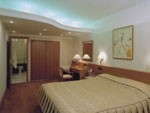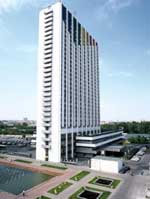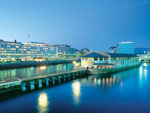If today you ask someone to show you the location of Moscow Art Theatre, you will be told to clarify which one you need. Today two theatres operate in Moscow: Moscow Art Theatre (MKhAT) named after Gorky and Moscow Art Theatre (MKhT) named after Chekhov. Years ago it used to be one single theatre that launched a new epoch of theatrical art.
Two great theatrical figures ,whose names are known today to everyone who has at least any idea about theatrical art, met at the Moscow restaurant Slavyanskiy Bazaar on 19 June 1897. They were Konstantin Sergeevich Stanislavsky and Vladimir Ivanovich Nemirovich-Danchenko. That day two geniuses decided to establish a new theatre which would embody an idea nowadays known as Stanislavsky's system.
They formed Art-Public Theatre that opened on 14 October 1898 by a premier of the play Tsar Fedor Ioanovich. The theatre troupe consisted of students of Stanislavsky and Nemirovich-Danchenko. The success of performance was so impressive, that its 100th staging took place 26 January 1901. And on 17 December 1898 the theatre staged the legendary premiere of Chekhov’s work Seagull. All this marked a true reform that brought theatrical art to completely new level.
But at the same time the theatre had problems with a building, the finance, and other. As there was no place to store scenery, they were stored in sheds where they quickly deteriorated and the theatre had to make new ones. The prices for tickets had to be increased, and consequently the theatre lost the title public, later renamed into Moscow Art Theatre (MKhT). The theatre turned into the association based on equal shares where the management consisted of rich patrons of art and also Stanislavsky and Nemirovich-Danchenko. Much later, well known philanthropist Savva Morozov undertook the theatre financing.
In 1902 the theatre moved to a building in Kamergersky lane. It underwent total reconstruction under command of architect Fyodor Schehtel. The building was completely resotred by summer 1902: the rotary circle of a scene was created, holds and warehouse were designed. It was then when the theatre received its emblem- a seagull flying over waves. The auditorium contained 1,200 seats.
Theatre became one of the most popular theatres of Moscow. Since 1906 it began touring in Europe, America and Asia. In 1920 it received the academic status, and since then was titled Moscow Art Theatre (MKhAT). It was named after Gorky in 1932.
It is necessary to notice the opening of Moscow Art Theatre museum in 1923, with two branches at premises of Stanislavsky and Nemirovich-Danchenko. At first, the museum was located in a theatre building, and then it was moved to the neighboring facility. In 1969 the museum outgrew the departmental limits, was removed from the direction of the theater and became a Union museum. Besides the historical documents, there are works of set design and memorial items, connected with history and the modern activity of the Art Theatre.
The beginning of Great World War fell on Moscow Art Theatre tours in Minsk. The troupe has returned to Moscow on 29 June, and in October 1941 was evacuated to Saratov where it appeared on stage local Youth Theatre. Some members of the troupe part were sent to Nalchik, and then to Tbilisi. But in November, 1942 the theatre returned to Moscow. The second founder of Moscow Art Theatre died in 1943, and the school-studio of named after Nemirovich-Danchenko was established.
Moscow Art Theatre faced crisis in 1960s: the repertoire was filled with imperceptible plays, the troupe saw the alternation of generations, and absence of constructive criticism led to stagnation in creative search. Oleg Efremov who came to the post of theatre director in 1970 breathed new life into theatre. He chose plays that would be perfect for the troupe and thus the theatre was reborn. In 1973 the theatre moved from Kamergersky lane to a new building at Tverskaya boulevard. The old building was closed for repair since 1978.
1987 is another important period for MAT’s- as a result of conflict its troupe divided into two separate theatres: MKhAT named after Gorky and headed by T.V. Doronina and MKhT named after Chekhov and headed by Oleg Yefremov. MKhAT named after Gorky stayed in a new building while MKhT returned to old premises at Kamergersky lane.
Certainly, it is a pity that the theatre divided into two parts, but on the other hand, now Moscow has two successors of the theatre based by great Stanislavsky and Nemirovich-Danchenko. Both of them follow the traditions that appeared a century ago, and their repertoires are based on classics that has always gloried the Russian theatrical art throughout the whole history of Moscow Art Theatre.







